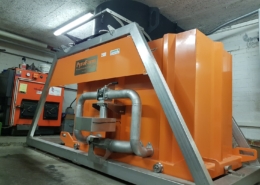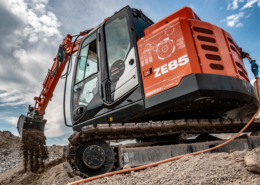Subsidies for biomass plants newly regulated
Biomass plants for electricity production can now benefit from investment contributions. New plants, significant expansions and renovations will receive up to 50 percent of the eligible investment costs. Sludge incineration and landfill gas plants can also apply for contributions. Wood-fired power plants and biogas plants can additionally receive contributions to operating costs (BKB).
The new subsidy model has been in force since the beginning of January 2023. The newly applicable scheme is a bridge between the expiring previous support system and the entry into force of the new energy law, which is currently being discussed in parliament in the Federal Act on a Secure Power Supply with Renewable Energies. The current regulation goes back to the parliamentary initiative of Bastien Girod (Greens, Zurich).
Due to the new situation, many questions from the biomass sector reach the Swiss Federal Office of Energy (SFOE). Energeiaplus with answers to the most frequently asked questions.
Only biomass plants for electricity production are subsidized. Why?
The measure serves to strengthen the security of electricity supply. It is financed from the grid surcharge fund. All electricity consumers pay the grid surcharge via the electricity price. It is used to promote renewable electricity. Plants that only produce heat, for example, cannot be subsidized via the grid surcharge fund. Biogas plants that process gas and feed it into the grid cannot be subsidized by the federal government because there is no legal basis for this. The CO2 Act, which was rejected by the people in 2021, would have opened the door for this.
What is the situation for existing biomass plants? Will they be left empty-handed?
The existing plants benefit from the feed-in tariff system (EVS /KEV) or from the additional cost financing (MKF) until the end of 2025. Plants that leave the EVS /KEV or MKF can now receive operating cost contributions.
If an existing plant that is not in a previous support system undergoes a significant expansion or renewal, it can also benefit from investment contributions.
Biomass plants will therefore receive up to 50 percent of the eligible investment costs. What does "up to" mean? And what does "eligible" mean?
The investment contribution is determined by plant category: Biogas plants receive 50 percent of the eligible investment costs, wood-fired power plants 40 percent, and MSW, sludge incineration, sewage gas and landfill gas plants 20 percent, provided the review of the application is positive. There are also maximum amounts per category that cannot be exceeded.
Eligible costs are those directly related to the plant's electricity production. If certain parts of the plant are also used for other activities, they can only be credited proportionally. Planning and project management costs are eligible up to a maximum of 15 percent of the eligible construction costs. Land costs or value-added tax, for example, are not chargeable to the respective costs.
When and how can the application for investment contributions be submitted?
The application can be submitted when a legally binding building permit has been issued or, if no building permit is required, when the project has been proven to be ready for construction. The application forms are available on the SFOE website under "Funding". Applications are processed according to the date of receipt.
What happens next? When is the investment contribution paid out?
The SFOE examines the application and decides on its support. In the event of a positive decision, a decision in principle is issued in which the maximum amount of support and the payment schedule are specified. The investment contribution is paid out in several tranches. In how many tranches depends on the total amount of the grant. The first tranche is usually paid out at the start of construction, another after the plant is put into operation. Before the last tranche is paid out, the construction completion report, construction cost statement and data from the first full year of operation must be submitted. Subsequently, the definitive eligible investment costs are checked and the definitive investment contribution is determined on the basis of a final decision. The final investment contribution may not exceed the maximum subsidy amount from the basic decision.
When can you start building?
Anyone wishing to benefit from investment contributions may not start work on site until the SFOE has guaranteed the amount. Ordering plant components does not count as work on site and may therefore be carried out before the SFOE has issued its decision. An early start of construction is possible if the SFOE approves the application.
What has to be considered for the operating cost contributions?
Operators of biogas plants and wood-fired power plants can submit an application for operating cost contributions to Pronovo AG. It is important to know: Even when receiving operating cost contributions, the operator continues to sell its electricity on the free market. From Pronovo, it receives the corresponding contribution rate minus the reference market price per kWh fed into the grid, regardless of the real sales price. If the reference market price exceeds the contribution rate, the excess is charged to the plant operator. The subsidy is initially limited until December 31, 2030.
In contrast to the regulations for the feed-in tariff system (EVS), a biomass plant can receive an operating cost contribution again after waiving the operating cost contribution after going through a new application procedure. However, the operating cost contribution is granted again at the earliest one year after the last exclusion or waiver
Is the ecological added value of the electricity produced already compensated with the investment contribution or the BKB?
No. In contrast to the EVS, the ecological added value is neither compensated by the investment contribution, nor by the operating cost contributions. The ecological added value can be sold in the form of guarantees of origin to an electricity supply company or on an electricity exchange.
What challenges still exist for biomass plants?
Biomass is a limited resource. In many regions, demand for energy wood or fermentable substrates (so-called co-substrates) already exceeds supply, which also affects prices. Careful and long-term planning of resources is absolutely necessary.
When it comes to long-term planning, another challenge comes into play: financial planning security. The current time limit on operating cost contributions until 2030 is unsettling for many potential project designers and funders. How things will continue after 2030 is an open question.
Furthermore, purely agricultural biogas plants without co-substrates will now be specifically subsidized, which also poses challenges. In Switzerland, there is still hardly any data on such plants, and despite the subsidy conditions, they must be very well planned and calculated to avoid disappointment. The time required by the operator for planning, construction and operation is often underestimated. Administrative and financial procedures, regulations and standards for biogas plants involve a lot of work in front of the computer. Especially for small plants this is very important. According to our estimation, it is worthwhile for farms with about 250 cows or more to consider a pure farmyard manure plant. This results in a plant with about 50 kW. In order to be able to plan as realistically as possible, Ökostrom Schweiz, the association for agricultural biogas, has published a leaflet with many important tips with reference to the new framework conditions (link below).
Nathalie Bachmann, Specialist Renewable Energies, Swiss Federal Office of Energy
Daniel Binggeli, Renewable Energy Specialist, Swiss Federal Office of Energy
Picture: keystone-sda: Biogas plant on a farm in Ittigen. Biogas is produced from guelle, manure and other organic waste. In the combined heat and power plant, electricity and heat are produced from the biogas. This is fed into the grid and can supply more than 300 households.
Important links:
- Fact sheet for agricultural biogas plants: Green electricity: new subsidy system at a glance (oekostromschweiz.ch)
- Application documents and fact sheet for IB: Investment contributions biomass (admin.ch)
- Application documents and guideline BKB: Forms and documents - Pronovo AG
- Green electricity Switzerland
- Biomass Switzerland
- Wood Energy Switzerland
- Fachgruppe Holzenergie | Swiss Association for Environmental Technology(svut.ch)
 keystone-sda
keystone-sda
 3 Vote(s), Durchschnitt: 4,67
3 Vote(s), Durchschnitt: 4,67 Fridolin HanelEnergie und Pflanzenkohle aus neuen Quellen
Fridolin HanelEnergie und Pflanzenkohle aus neuen Quellen  Umwelt ArenaWie in Urdorf ZH das Wohnen der Zukunft gebaut wird
Umwelt ArenaWie in Urdorf ZH das Wohnen der Zukunft gebaut wird  MESH4UDes stations de recharge au service du réseau électrique
MESH4UDes stations de recharge au service du réseau électrique  SUNCAR HK AGElektrobagger senken CO2-Emissionen auf Baustellen
SUNCAR HK AGElektrobagger senken CO2-Emissionen auf Baustellen 
 BFE
BFE BENEnergy
BENEnergy
Neuste Kommentare